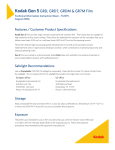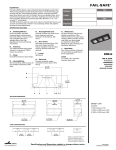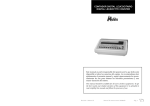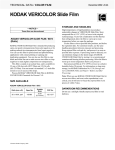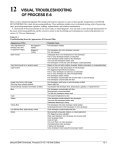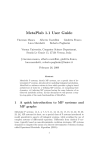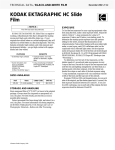Download Kodak CGP7 User's Manual
Transcript
Kodak CGP Camera 2000 Film Kodak CGP7 Camera 2000 Film Kodak CGPM Camera 2000 Film Technical Information Instruction Sheet – TI1995 August 2006 Features / Customer Product Specifications • An extremely high-contrast, orthochromatic film. • For graphic arts line, halftone, and contact applications. • Dimensionally stable Estar base. • Compatible with other Kodak products processed in easy-to-use Kodak RA 2000 developer and replenisher (for machine or tray processing). • CGPM film has a special matte surface on the emulsion side for rapid, uniform vacuum drawdown when using flexographic or smooth-surface printing plates. Safelight Recommendations Use a Kodak 1A safelight filter / light red in a suitable safelight lamp equipped with a 15-watt bulb. Keep the film at least 4 feet (1.2 metres) from the safelight Storage Keep unexposed film and processed film in a cool, dry place. Process film as soon as possible after exposure. Exposure Relative Exposure Index Exposure Orientation To emulsion System Pulsed-Xenon ISO (ASA/DIN) Tungsten or Quartz-Halogen 20/14 20/14 These indexes are provided primarily as indicators of the relative speed of this film when compared with other Kodak graphic arts photographic materials. The pulsed-xenon value indicates the film's relative speed to pulsed-xenon illumination as measured by a light integrator. Index numbers for the other light sources can be used with photoelectric exposure meters to help establish trial exposures. A 2-times film-speed increase is indicated in the ASA system by doubling the index number and in the DIN system by increasing the number by 3. Examples of Camera Exposures • Line Exposure: For a same-size (1:1) line reproduction exposing with four 1500-watt pulsed-xenon lamps at 3 feet (0.9 metre) from the center of the copyboard, use a trial exposure of 8 seconds at f/22. • Halftone Exposure: Make a trial exposure using a contact screen suitable for use with Kodak Camera 2000 films. Example of Contact Exposure Exposing with a variable voltage point-source lamp operated at 16 volts at a distance of 5 feet (1.5 metres) from the exposure plane—approximately 4 footcandles (43 lumens/square metre), use a trial exposure of 6 to 11 seconds (with a 1.0 neutral density filter), to the emulsion. Filter Factors When a filter is used, multiply the amount of unfiltered exposure by the filter factor shown below. Because lighting conditions vary, these factors may require adjustments. Light Source No. 8 Kodak Wratten Gelatin Filter No. 15 No. 47B No. 58 Pulsed-Xenon 1.5 2.0 12.0 4.0 Quartz-Halogen 1.5 2.0 20.0 2.5 NOTE: It is recommended that the manufacturer of the pulsed-xenon or quartz-halogen lamps be consulted for safety information pertaining to ultraviolet radiation and ventilation requirements due to ozone generation. Mechanized Processing NOTE: Contamination of the developer with small amounts of fixer may result in speed or density loss. Notice: Observe precautionary information on products labels and on the Material Safety Data Sheets. The recommended starting point for optimum results for optimum results using Kodak RA 2000 developer and replenisher (1:2) are: Deep-Tank Processors 120 seconds at 75° F (24° C) 105 seconds at 80° F (27° C) 90 seconds at 85° F (30° C) Rapid-Access Processors 30 seconds at 95° F (35° C) Use a fixer such as Kodak RA 3000 fixer and replenisher. As a starting point, do not add hardener to the fixer. However, if abrasion or any other transport problems occur in processing, add 3.2 oz of Kodak RA 3000 fixer, part B (hardener) per working-strength gallon of fixer. Add part B following recommended instructions (slowly and mixing thoroughly). © Kodak, 2006. Kodak, Estar, and Wratten are trademarks of Kodak. Kodak CGP Camera 2000 Film Kodak CGP7 Camera 2000 Film Kodak CGPM Camera 2000 Film Technical Information Data Sheet – TI1995 August 2006 1. Support Dimensionally Stable Support CGP 4 mil (0.004 in., 0.10 mm) Estar base CGP7 7 mil (0.007 in., 0.18 mm) Estar thick base CGPM 4 mil (0.004 in., 0.10 mm) Estar base, with matte 2. Graphs1 Characteristic A. CGP and CGP7 films (6-92) B. CGPM film (12-92) Spectral Sensitivity C. (8-92) 1 NOTICE: While the data presented are typical of production coatings, they do not represent standards that must be met by Kodak. Varying storage, exposure, and processing conditions will affect results. The company reserves the right to change and improve product characteristics at any time. The Kodak products mentioned in this document may not all be available in all regions or countries. If you have questions or need assistance, contact your local Kodak representative or visit our website: http://graphics.kodak.com. The contents of this publication are subject to change without notice. © Kodak, 2006. Kodak and Estar are trademarks of Kodak.







